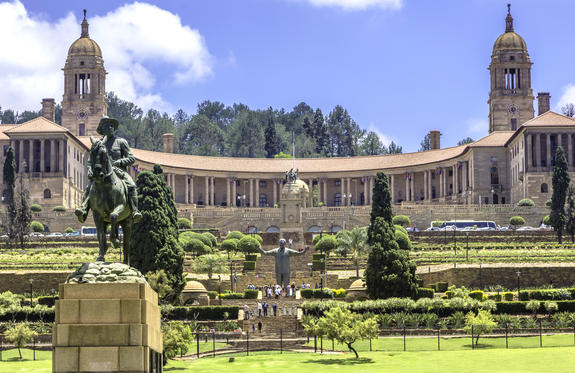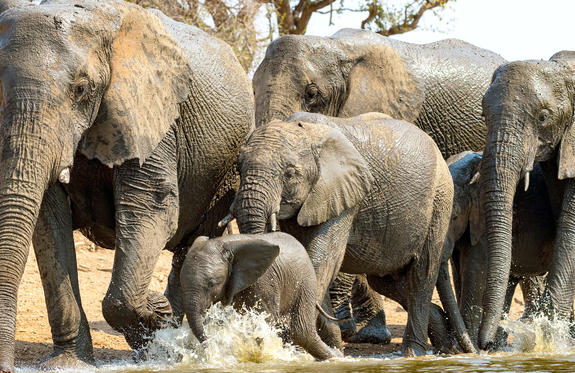One of the most culturally and geographically diverse places on earth, South Africa, fondly known by locals as the 'Rainbow Nation', boasts 11 official languages, and its inhabitants are influenced by a fascinating mix of cultures. Discover the gourmet restaurants, impressive art scene, vibrant nightlife, and beautiful beaches of Cape Town. Enjoy a local braai (barbecue) in the Soweto township, browse the bustling Indian markets in Durban, or sample some of the world's finest wines at the myriad wine estates dotting the Cape Winelands. Some historical attractions to explore include the Zululand battlefields of KwaZulu-Natal, the Apartheid Museum in Johannesburg, and Robben Island, just off the coast of Cape Town. Above all else, its untamed wilderness is astonishing: wildlife roams freely across massive unfenced game reserves such as the world-famous Kruger National Park.

The interior of the Northern Cape is known as the Great Karoo with vast majestic vistas in every direction. Here you will find diamond town of Kimberley. Once the second largest settlement in South Africa and home to the first stock exchange in the country, Kimberley was also the first town in the southern hemisphere to install electric street lights.
For visitors, Kimberley is best known for the Big Hole, all that was left by the early Diamond Rush. It is amazing to think that it was dug by hand. The Big Hole as well as the restored diamond village, forms the Kimberley Mine Museum. There’s a reconstruction of a typical Kimberley Street during the diamond boom. There is also a remarkable display of vintage cars.
The other fascinating aspect of Kimberley for history enthusiasts is that it is surrounded by some well-known battle sites of the Anglo-Boer War such as Magersfontein Battlefield and Modder River Battlefield. The Magersfontein site can be easily visited under your own steam, but we recommend a private tour with a local guide.

The country's gracious administrative capital, Pretoria is famous for its flowering jacaranda trees in springtime, (September and October), when the city is blanketed with their purple blossoms. Founded in 1855, the city was named after Andries Pretorius, the hero of the Battle of Blood River. It was the capital of the newly independent Zuid Afrikaansche Republiek from 1860 to 1910. Jan Smuts House, Church Square, the Union Buildings, and the Voortrekker monument are all full of historical interest. It is also home to the country's most successful rugby team, the Blue Bulls.

Bordering Botswana in South Africa’s North West Province, Madikwe Game Reserve is the fifth-largest reserve in the country and is home to a great number of animal species. It contains a wild dog reserve, and is inhabited by the world-renowned Big Five, as well as Brown Hyenas, Cheetahs, and Aardwolf. Visitors will also be surrounded by over 300 bird species, including vulture, ostrich, and the large kori bustard. The landscape is characterised by vast grasslands, woodlands, and the rugged Tshwene Tshwene hills - creating enthralling scenes that often attract photographers and artists. Visitors can look forward to sunset drinks overlooking the Madikwe Dam. Madikwe Game Reserve is one of the only reserves in South Africa that is malaria free.
A nation of spectacular natural beauty, friendly people and rich culture, Zimbabwe’s status as one of Africa’s leading safari destinations was dampened for years by its political instability. But now that the country is transcending its strife and returning to a state of equilibrium, it is once again emerging as a vacation highlight of the continent. Victoria Falls – known to locals as ‘The Smoke That Thunders’ – is one of the seven natural wonders of the world and the sheer power of this massive body of water plunging into the Zambezi Gorge is awe-inspiring and unforgettable. Lake Kariba, with its game-rich shores and islands, is an idyllic safari spot featuring mind-blowing sunsets; Hwange National Park is known for its huge herds of elephants; and a kayak trip down the Zambezi through the Mana Pools National Park will appeal to the intrepid traveller, providing close encounters with crocodiles, hippos and a host of other wildlife.

The Victoria Falls, one of the Seven Wonders of the World, is a sight not to be missed. Especially when the Zambezi river is in full flow (April to June/July) when over a mile of unbroken surging water plunges into the Zambezi gorge below. The pleasant town is compact enough to walk around and the Falls are within easy walking distance.
The Victoria Falls is bordered by Zimbabwe and Zambia and each country offers a different viewing perspective. Towards the end of the dry season, from late September to January, the spectacle is best seen from the Zimbabwe side of the Victoria Falls.
A host of activities are on offer centred around the Falls themselves, the magnificent Zambezi River and the Zambezi National Park. Enjoy guided tours of the Falls and then a languorous sunset boat cruises. To gain an overall impression of the Falls, the helicopter 'Flight of Angels' is essential. A microlight ride and bungee jumping are available for the more daring. The wide gentle river above the Falls is the perfect place for canoeing and fishing, whilst below the Falls, the serious white-water rafting or jet-boating is on offer. Game drives and horse riding are offered in the Zambezi National Park to view elephant and buffalo, or you can take a day safari to nearby Chobe National Park. You can also sample elephant back safaris and interactions.
This unique, peanut-shaped country, once known as Northern Rhodesia, offers visitors an authentic African experience complete with adrenalin pumping adventure sports, a variety of fascinating cultural activities, and an abundance of indigenous wildlife, which finds refuge in Zambia’s vast national parks. Spend your evenings enjoying the spectacular site of the world’s largest waterfall, the Victoria Falls, while sipping on sundowners after an exhilarating day of whitewater rafting down the rapids of the mighty Zambezi River. If that sounds a little too adventurous for your taste, take a houseboat cruise along the exquisite Lake Kariba while watching wild elephants drink at the riverbank as you try your hand at catching the elusive tiger fish. However you choose to spend your time in this unique country, you are bound to leave with a heavy heart and a desire to return again soon to this exceptionally beautiful Southern African country.
Kasama, the capital city of the Northern Province of Zambia, lies at the centre of an important road network providing fast access to the other provinces. Not only a thriving commercial hub, filled with shops, restaurants, services and an airport, the town is also home to some extraordinary natural and cultural attractions. Surrounded by rugged green mountains, lush vegetation, and wide-open plains abundant in wildlife, the area is popular with outdoor enthusiasts, nature lovers and those interested in African animals. The nearby Chishimba Falls, regarded by the Bemba people as a highly sacred place, is a spectacular sight to behold - where three successive falls merge into one magnificent display. Close to the falls, the well-preserved Mwela Rock Paintings allow visitors a peek into the thoughts of ancient cave dwellers.
The name Tanzania conjures up images of wildebeest stampeding across vast savannah, rain forests teeming with monkeys and birdlife, and great plains brimming with legions of game. All of these natural wonders and more are on offer in this exceptionally diverse African nation. Visitors typically visit Tanzania to partake in at least one of the four well-known Tanzanian tourist experiences: a relaxing seaside vacation on the picturesque island paradise of Zanzibar, an underwater tour of some of the world’s most renowned dive sites around the gorgeous Spice Islands, a safari adventure in some of Africa’s most impressive game reserves, or a hiking excursion around Mount Kilimanjaro National Park. Whichever of these incredible holidays you choose, you will undoubtedly be welcomed by some fabulously friendly and peaceful inhabitants who, despite being divided into 120 different ethnic groups and cultures, live in harmony with one another and provide some of the most wonderfully exotic local cuisine you could imagine. With all of this diversity on offer, the most difficult part of your Tanzanian holiday experience is likely to be deciding where to go!
Makambako, a stopover town along the acclaimed Tazara railway line, is a small but charming town located within the Njombe Region of wonderful Tanzania. Geographically, Makambako, marks the end of the wondrous Eastern Arc Mountain Range and the start of the bird watching and hiking haven of the Southern Highlands. Travellers to Makambako can meander along its lively streets, sample the delicious local cuisine or interact with locals at one of the bustling markets. With its charming small-town feel, this highland town acts as the perfect base for exploring the surrounding scenic landscapes, including the unique flora and fauna of the flourishing Mpanga-Kipengere Game Reserve.

Formerly the northern part of Selous Game Reserve, Nyerere National Park is Tanzania's largest National Park. Stretching over an impressive 30,893 square kilometres, the park is home to some of the world’s largest concentrations of wildlife, and the incredible diversity and sheer volume of animals draw visitors from around the globe. Travellers can look forward to spotting a wide collection of common and rare species including the famous Big Five, some rare species of antelopes like Roan Antelope, and large concentrations of elephant and hippos. Don’t miss the opportunity to take a boating safari on the exquisite Rufiji River, spot the endangered African wild dog, and enjoy a guided walking safari with a highly knowledgeable guide.

Dar es Salaam is Tanzania’s former capital, her largest city and main port. The distinctly African, colourful markets are well worth a visit and both German and British influences can still be seen in the architecture around the city. Conveniently positioned amidst some of the most important sea routes in the world, the city is the transport and economic hub of the country as well as a centre for arts and culture. It serves as an excellent jumping-off point to explore the surrounding area including Pemba, Mbudya, Unguja islands, a variety of national parks and countless pristine beaches. Visitors can look forward to a number of other activities including: learning about Tanzanian culture at the National Museum and House of Culture, visiting the eclectic Oyster Bay, and taking a stroll through the city's lush Botanical Gardens.





